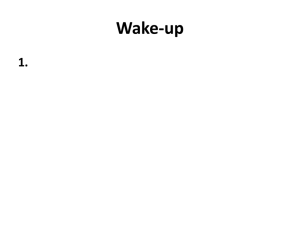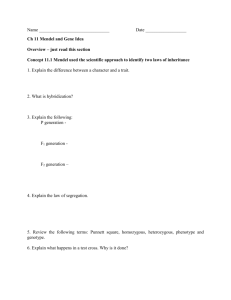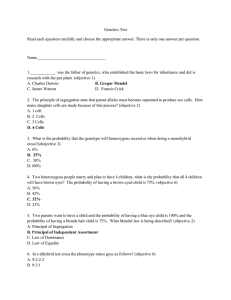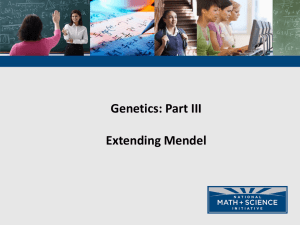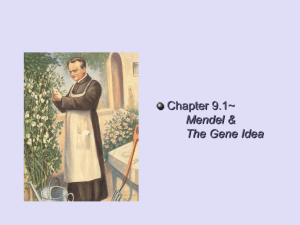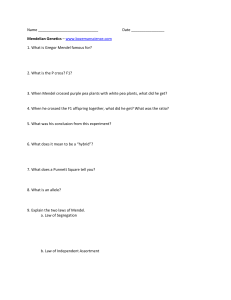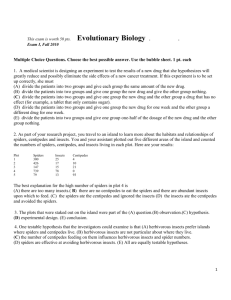Activities Cell Division Chapters 12-15
advertisement
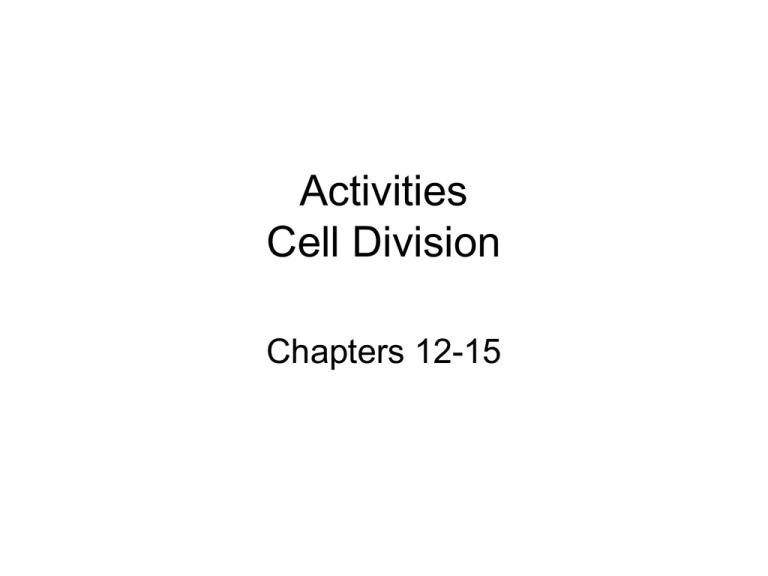
Activities Cell Division Chapters 12-15 • Is this one n or 2n? n • Identify – Chromatid (DNA) – centromere – chromosome arm Identify the parts pointed at • name the stage • metaphase Spindle from centrioles • what stages come before and after this one? • Prometaphase (or prophase) chromosome centrioles what organism is this tissue from? plant name the stages A-E E telophase F D prophase which of these is not an M stage? B metaphase interphase where in the plant you C find this tissue? interphase meristem what is "F"? Cell plate A metaphase • name the stage anaphase • what stage comes before and after it? Metaphase; telophase • if this is a somatic cell and n=10, how many chromosomes will it have? 20 • name the stage interphase • is it part of mitosis? no • give a visible characteristic. Nuclei are visible, cytoplasm has one color tone. • what happens during this stage, why is it important? DNA replication, to have chromosomes ready for the daughter cells • Is this cell going through mitosis or meiosis? mitosis • How do you know? There has been no exchange of DNA between homologous chromosomes • Is this cell going through mitosis or meiosis? meiosis • How do you know? Crossing-over is taking place between homologous chromosomes • What specific stage is it in?P1 • What special process is going on? Crossing over • What is the importance of it? Genetic variability in the population Prophase I Metaphase I Anaphase I Telophase I • zsdvsfbdb Prophase II Metaphase II Anaphase II Chromosome number = 2n = 20 Is this mitosis or meiosis? meiosis Chromosome number = n = 10 Name all the stages. If 2n= 20 what is the number of chromosomes on each stage? What type of cell will this occur in? gamete, reproductive cell Telophase II B • • • • • • Name the form of cell division A seen here. meiosis What is the name of the process seen in the second picture? (D) Crossing over What stage of meiosis does the second picture represent? PI Why is 'D' important for human race and species in general? Genetic variability Name the stages with letters C & E C= telophase II, E= metaphase I Determine the number (n or 2n) n or 2n? of chromosomes in B, C and E. n or 2n? 2n D E n or 2n? n C • • • • What is a homozygous? Same exact genes in each locus What is a heterozygous? Different genes in each pair of loci what is a dominant allele? The one that overpowers the recessive What is a recessive allele? The one who’s expression is overpower by the dominant trait • What is complete dominance, incomplete dominance and codominance? Look in book • What is F1 and F2? F1 is first generation, F2 is second generation Using the letter R, draw a Punnett square with a homozygous dominant and a homozygous recessive and find the F1. j J Jj J Jj j Jj Jj All F1 will be heterozygous (Jj) Law of Segregation PP • P= dominant and p=ressesive • using the symbols given: – fill in the blanck spaces with the proper symbols – what is the genotype of each of the F1? – Using two heterozygotes of F1, make a Punnet square and find the F2. – What are the proportions of the phenotype in the F2? – What are the proportions of the genotype in F2? pp P p F1 Pp F1 gametes P p P p P PP F2 Pp p Pp pp YYRR Law of Independant Assortment • Fill in the gametes and Punnett square • What are the genotype and phenotype of F1? Yellow and smooth • What are the proportions of the genotype and phenotype of F2? 9 yellow and smooth (Y_R_) 3 yellow and rough (Y_rr) 3 green and smooth (yyR_) 1 green and rough (yyrr) yyrr YR yr YyRr YR F1 Yr yR yr YYRr YyRR YyRr YYrr YyRr Yyrr YR YYRR Yr YYRr yR YyRR YyRr yyRR yyRr YyRr Yyrr yyRr yyrr yr F2 Incomplete dominance • Write down the symbols of each generation (P, F1 and F2) • Write down the genotypes and gametes produced by P and F1. • Fill in the gametes in the Punnett square and find out the genotypes and their proportions of the possible F2 offspring. 1:2:1 red (CRCR), pink (CRCW), white (CWCW) CRCR CWCW CR CW CRCW (pink) CR CR CR CW CW CRCR CRCW CW CRCW CWCW Codominance IAD • • • • • • Put the possible gametes of generation P, both of blood type AB+ (assuming the Rh is heterozygous) Find out the genotype and phenotype of the F1 Determine the proportions of each one of the phenotypes of F1. AB+ = 6 A+ = 3 AB - = 2 B+ = 3 A-=1 B-=1 IBD IAd IBd IAIBDD AB+ IAIADd A+ IAIBDd AB+ IAD IAIADD A+ IBD IAIBDD AB+ IBIBDD B+ IAIBDd AB+ IBIBDd B+ IAd IAIADd A+ IAIBDd AB+ IAIAdd A- IAIBdd AB – IBIBDd B+ IAIB dd AB - IBIBdd B- IBd IAIBDd AB+ • what is the difference between the next gene mutations Look in book. – Deletion – Duplication – Inversion – reciprocal translation define: • syndrome • disorder • aneuploid • trisomic • oogenesis
